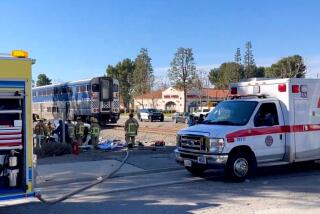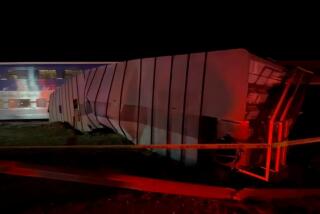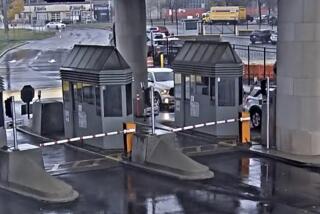Investigators scour N.Y. train wreckage; death toll stands at 6
A 400-foot chunk of electrified rail sliced through an SUV, punctured its fuel tank and pierced the first and part of the second car of a commuter train, investigators said Wednesday as they pieced together details of a fiery crash that killed six people north of New York City.
National Transportation Safety Board Vice Chairman Robert Sumwalt said the agency was focusing on two main questions as it began investigating Tuesday evening’s crash in the Westchester County town of Valhalla: why the SUV driver was on the tracks, and why the accident killed so many people on the train.
“That’s really going to be the heart of it,” Sumwalt said at a news conference. He said rail-crossing accidents were not rare, but they usually did not result in fatalities on trains. Part of the investigation will be to examine the crashworthiness and strength of the rail cars on the Metro-North train, Sumwalt said.
Four people remained hospitalized Wednesday, including one in critical condition. Officials had not yet identified all of those killed, who included five men on the train and the female SUV driver.
Late Wednesday, MTA police Sgt. Dwayne Pouncey identified the driver as Ellen Brody, 49, of Edgemont, N.Y., and one of the dead train passengers as Eric Vandercar, 53, of Bedford, N.Y. A third victim who died was Walter Liedtke, a longtime curator at the Metropolitan Museum of Art, the museum tweeted.
Brody was a jewelry store employee and a mother of three who lived in Westchester County, local media reported.
Rick Hope, who was behind Brody’s car during a traffic tie-up Tuesday, has said she was in one of many cars inching along a street that is traversed by the railroad track. At one point, traffic came to a halt, and Brody stopped inside the crossing gate line. Suddenly, Hope said, the gate came down on the car and lights began flashing, indicating Metro-North’s No. 659 out of Grand Central Terminal was coming up the track.
Instead of hurrying off the track, though, Hope said the SUV’s driver got out of her car and walked around to the back, as if to check for damage from the lowered gate. Then, instead of backing up, Hope said, she got back into her car and drove forward about 15 feet.
It is not clear whether she was trying to beat the train or whether she was confused in the darkness and did not realize she was in peril, Sumwalt said.
The force of the crash pushed the SUV about 1,000 feet up the track. As the train barreled forward with the SUV wrapped around its front, the track’s electrified third rail became dislodged and penetrated the SUV’s chassis and fuel tank. The rail then impaled the train, where it spread a fire fueled by the SUV’s gasoline.
“The entire interior of the first rail car was burned out,” he said.
Sumwalt said investigators would be at the site for five to seven days collecting evidence and interviewing witnesses. He said experts would study the crossing gates, signals, tracks and the train’s black-box-type recorders to determine how fast the train was traveling and whether brakes were applied before impact. The express train should have been traveling about 60 mph on that stretch, which is about 20 miles north of New York City.
“We intend to find out not only what happened, but we want to find out why it happened,” Sumwalt told reporters. “And our sole purpose for being here is to find out what happened so that we can offer recommendations to hopefully keep this from happening again.”
Westchester County Executive Rob Astorino said earlier Wednesday that it was a “minor miracle” when a search of the wreckage determined there was one fewer fatality than initially reported.
“That train had so many flames and it was so engulfed, the inside of that first car is just melted and charred,” Astorino said.
The train had eight cars and had left Grand Central about 5:45 p.m., with hundreds of people on board. Nearly 24 hours after the crash, it remained on the tracks as federal investigators scoured the wreckage for clues and collected photographic evidence.
It was the worst crash in the history of Metro-North, the country’s second-busiest commuter railroad. Until 2013, the railroad prided itself on having never suffered a passenger fatality, but on Dec. 1, 2013, a speeding train derailed in New York City and killed four people. Earlier that year, two trains collided, injuring 60 people; and a Metro-North employee died when he was hit on the tracks by a train.
The NTSB subsequently issued a report accusing Metro-North of sacrificing safety in its quest to keep trains running on time. Among other things, it said the train involved in the December 2013 crash was traveling at more than 80 mph when it entered a curve zoned for about 30 mph. It also said the driver, who said he had “zoned out” briefly, suffered from severe sleep apnea but had not received proper medical screening.
Officials say that early information does not indicate the railroad was at fault in the latest incident.
Times staff writer Christine Mai-Duc in Los Angeles contributed to this report.
More to Read
Start your day right
Sign up for Essential California for news, features and recommendations from the L.A. Times and beyond in your inbox six days a week.
You may occasionally receive promotional content from the Los Angeles Times.







